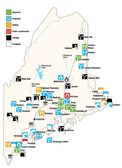Wind backers hail credit extension
Wind power developers and industry regulators in Maine expect a busy year following the extension of federal tax credits for wind projects. Projects already seeking state permits are expected to hurry to start construction before a year-end deadline. However, industry observers say uncertainty leading up to the last-minute federal extension — which came with Congress' fiscal cliff deal in early January— will keep developers from looking at new wind farm construction through the first half of the year.
"The problem is, like a locomotive, [projects] don't start or stop on a dime," says Jackson Parker, CEO of the Woolwich-based construction firm Reed & Reed, which has seen wind power projects account for nearly half of its business over the last five years.
Still, with a quiet first and second quarter projected for 2013, Maine's wind industry is poised to double its capacity this year based on project applications now before the state's Department of Environmental Protection.
Interactive: View a breakdown of wind power projects currently before the DEP.
Currently, the state's 11 wind farms have the capacity to produce 468 megawatts of power; six new projects in various stages of approval would increase that capacity by 454 megawatts.
For Massachusetts-based Patriot Renewables, which has two projects totaling just over 50MW in the works, CEO Todd Presson says the tax credit extension will keep those projects on track.
"We're moving forward at the pace that we hoped to be able to," Presson says.
The tax credit extension applies to other renewable power sources besides wind, providing renewable energy developers with a tax credit based on power production or a credit based on new investments. Additionally, it gives new energy developments more wiggle room by requiring that qualifying projects merely begin construction rather than become operational as the previous credit had required.
That could put Maine wind projects now at a conceptual stage into play for the program. Boston-based wind developer First Wind is expected to resubmit an application for a 19-turbine expansion of its Bull Hill project by the end of this month, and other wind developers are eyeing sites in Moscow and Alder Stream.
For First Wind, CEO Paul Gaynor expects to increase the company's portfolio of operating wind projects in 2013 by 50%, or around 500MW, a level of growth he attributes to having a more certain future for federal tax credits through the year.
"There's a big funnel of projects and which of those actually make it through remains to be seen," Gaynor says, "but we have enough volume and enough backlog to buy the 50% of our current portfolio and we're pretty confident about that."
The company expects most of that growth to occur in Maine, as a 150MW project in Oakfield and a 48MW project in Carroll Plantation await permits. In addition, the application for a nearly 190MW Bingham Wind project is expected by the DEP later this month. If each project comes to pass, First Wind would quadruple its generation capacity in Maine.
Changes, challenges
The wind industry still awaits clarification from the Internal Revenue Service and Department of the Treasury around what stage of construction will qualify a new project for the tax credit program, but developers agree the change will be a boon.
Another change, however, might add more time to financing new projects, according to Gaynor.
The extension allocates tax credits to a project in one of two ways: providing $22 per megawatt hour produced over 10 years, or based on upfront investments.
Previously, a developer qualifying for the investment tax credit could opt to receive a federal cash grant early in a project's development. After he invested 5% of a project's cost, a cash grant worth 30% of the total project cost would be awarded.
That incentive structure has particular appeal for renewable industries, like wind, that require steep up-front investment.
While that incentive structure remains in the extension, the cash grant is gone; developers must now go to financial markets to sell their tax credits for early investment money.
That arrangement is not new to renewable energy markets, but Gaynor says the cash grant program was popular and the added financing step might take some extra time for developers to navigate.
"It may add a little complication or time, but they've done it on the solar side of things for some time now," Gaynor says.
Going forward, however, advancement in wind turbine technology could make the long-term production credit more appealing.
In a presentation delivered last year in Portland, Mark Bolanger, an energy researcher at the Lawrence Berkeley National Laboratory, showed that New England turbines increased rotor diameter by an average of nearly 20 meters in 2012, which increases turbine efficiency and, in particular, increases production in lower wind conditions. For Maine, Bolanger says that could make sites like First Wind's Bull Hill project, which he says is at an uncharacteristically low elevation, feasible.
Looking ahead, Bolanger projects that wind power will only become more competitive with other sources of power generation — like natural gas — though he and Gaynor note that direct comparisons are difficult.
"The demand [for wind] is coming from state renewable portfolio standards, so we're not really competing against natural gas," Gaynor says.
On top of that, Bolanger says power markets view the use of each resource differently. In a simplified explanation, natural gas can be fired up on demand and add capacity; wind can offset that fuel cost when turbines are moving.
With the tax credit extension, Bolanger says wind will continue to provide an effective long-term hedge for natural gas prices that he predicts will not get any lower.
Interactive map:














Comments